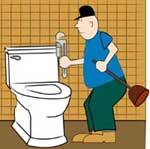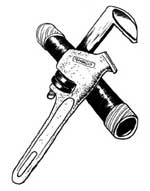|
Chimney Repair For the Family Handyman
A chimney repair should be a priority since the chimney is a vital part of any heating system. In some cases, a repair is not going to be enough. Older homes with masonry chimneys may require extensive work to get them to pass inspection and work efficiently. It may be beneficial to replace the masonry chimney with an insulated stainless steel type of chimney. I will cover this a bit later. If you have determined that your chimney is worth a chimney repair, rest assured that the resealing of chipped points and seams can be a fairly straightforward job for the family handyman. Here are some tools you may need:
Steps for completing the chimney repair job:Start the chimney repair at the very bottom and work your way to the top. With a hammer, chisel, and brush remove any loose mortar from around all sides of the chimney. Mix mortar according to directions on the label. Once all the loose mortar is removed in the section of chimney you are working in, start rebuilding by packing the mortar into the joint. This is done by holding one trowel just below the joint you are replacing and forcing mortar into the bottom half of the joint with the other trowel. Repeat and pack the upper half of the joint. Remove any excess mortar with a brick trowel to obtain a flat surface. Now it is time to shape the joint. Concave V joints are required between the bricks. This is easily acquired with a mason’s pointing trowel by running it across the joint to create a 30-degree bevel. Knock off excess mortar and continue to work your way up the chimney removing chipped and loose mortar and replacing with new.
Applying a water repellent breathable sealant over the entire mortar chimney after your repair can be a great preventative measure that could save you the hassle of yet another repair job in the near future. Water is often the culprit for brick problems, so protecting your chimney is a step in the right direction. An ounce of prevention is worth a pound of cureChimney repairs for cracks in the joints and cracks between the flue and the cap can be easily sealed with masonry caulking compound. For insurance purposes, the laws in some areas require that you have your chimney W.E.T.T inspected. A trained W.E.T.T. professional will come to your home and perform this inspection, for a price, and inform you the homeowner of things that need to be fixed or give it a pass or fail mark.
If your chimney repair includes a new cap be sure to install a stainless steel chimney cap. Yes, it will cost you a little extra money but it is well worth it. Why? Black chimney caps will cause stains to eventually appear on the chimney itself due to excess heat and elements. A metal chimney will eventually rust, causing another stain problem. A stainless steel chimney cap is your best value. Be sure to use a little bit of silicone to secure the cap to the top of your chimney during installation. This will usually prevent it from taking flight when strong winds of winter arrive. General tips to remember: Do not use stovepipe to go through walls, ceilings, floors or windows. Insulated stainless steel pipe is required in these areas. Generally, the fewer the number of bends in the pipe the better your draft will be. The chimney should extend two feet above anything within a ten-foot radius of it and or three feet above the peak of the roof. A chimney cap will usually prevent birds from entering. Common problems with older masonry chimneys: The chimney is no longer being used for the same purpose it was built for. Some were built for oil and gas burners and cannot withstand the excess heat of wood. Most masonry chimneys are too large and non-insulated. This results in poor draft and excess creosote formation, which causes chimney fires. Updated building codes have changed the minimal clearance allowed around combustible materials where your stovepipe connects to your chimney causing older masonry chimneys to be a fire hazard and a grievance for insurance companies. Special insulated sleeves are now available to accomplish this transition. Brick/masonry chimneys leave no room for expansion of the flue tiles, resulting in cracked and damaged liners that are hidden from the homeowner. These cracked liners can be at greater risk for flue fires. An existing masonry chimney can often be brought up to spec by installing an approved stainless steel liner system. This provides an extra margin of safety as well as improves draft and simplifies cleaning. Be sure to always maintain proper clearance and use non-combustible materials suitable for the type of heat source you have chosenReturn to Family Handyman Questions Home Page from Chimney Repair page
|
Family Handyman Quick Links
Looking for a Toronto plumber? Hiring a plumber can effectively fix your plumbing!
Download free Handyman clipart
Download free Handyman Business forms


